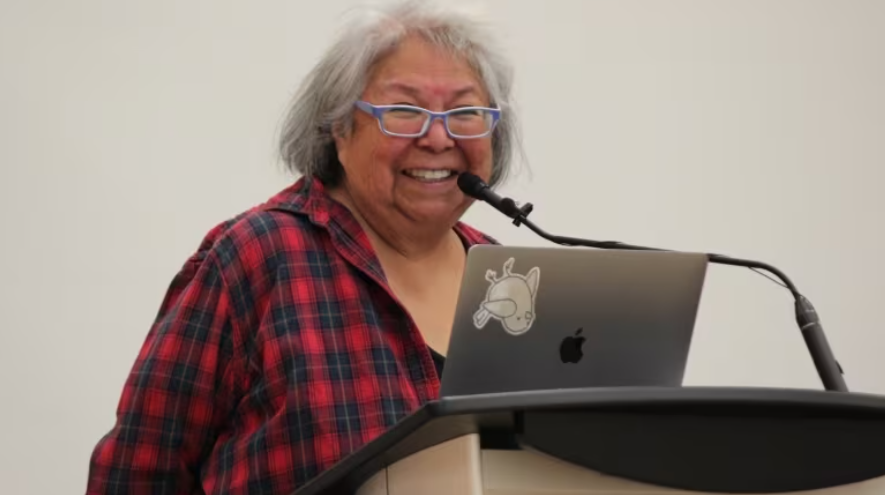
UM Faces and Spaces: Pat Ningewance-Nadeau, Department of Indigenous Studies
“It will be a special moment when a young person sees their own ancestral language spoken on the big screen in Star Wars.”
For this month’s UM Faces and Spaces feature we are highlighting, Pat Ningewance-Nadeau, an assistant professor in UM’s Department of Indigenous Studies, Order of Canada recipient (2022), Anishinaabemowin (Ojibwe language) teacher, author and publisher. Maintaining the vitality of Indigenous languages is her passion. Read on to find out more about Pat and her exciting role in the Star Wars universe.
UM Today: For hundreds of years, Indigenous peoples were stopped from speaking their languages across Manitoba and Canada. Despite that, Statistics Canada notes there are a diversity of Indigenous languages still being spoken, today. What does it mean to you to be part of keeping them alive and thriving?
Pat: I’m very grateful to have the skills, experience and knowledge to help keep my language alive and thriving. I’ve been writing and publishing Ojibwe language books for the past 20 years through my publishing company Mazinaate Inc. There are textbooks, a workbook, phrase books and an Ojibwe Thesaurus. They are all written in the standard double vowel orthography.
UM Today: How common is Anishinaabemowin and how valuable is it in reflecting the environment, from the land to people?
Pat: The Ojibwe language is still spoken in Saskatchewan, Manitoba and western Ontario. It’s not so common anymore in Minnesota, Wisconsin and Michigan.
How does it reflect our relationship to the environment? We can describe geography much differently. The language is polysynthetic—meaning it’s made up of morphemes—units of meaning. So, one can describe nature infinitely with one long word. Not like in English where we use smaller words. There are also two classes of grammar and vocabulary; animate and inanimate.
UM Today: Are you seeing a renewed interest in Anishinaabemowin and what positive steps can communities take to foster its growth?
Pat: Yes, there is renewed interest in the language amongst the youth. Twenty years ago, Introductory Ojibwe would have 15-20 students enrolled. Now, it’s more than 30. But we still need more awareness of the importance of the language, in the communities. There is a big gap between the fluent older adults and the young people. The young ones cannot speak the language so they cannot understand the speakers at public community events.
UM Today: You played a key role in translating Star Wars: A New Hope into Anishinaabemowin in partnership with UM, Dakota Ojibway Tribal Council (DOTC) and LucasFilm/Disney. How did you get involved and why was it important for you to take on such a key role?
Pat: My son, Maeengan Linklater, is the Director of Operations at Dakota Ojibwe Tribal Council (DOTC). Being a big Star Wars fan, he initiated the project when he heard of the Navajo version. I had done this kind of work before in Ontario, so I wrote the proposal and he developed it further with Cary Miller at UM and they submitted it to Heritage Canada. It got funded. I’ve translated all my life and I’ve done versioning in Ontario. It made sense to take the lead in this project.
UM Today: What do you think it will mean to future generations to see Anishinaabemowin featured in the Star Wars universe?
Pat: It will be a special moment when a young person sees their own ancestral language spoken on the big screen in Star Wars. It will mean that our language is relevant. It belongs here today. It is not a thing of the past.
UM Today: Can you share with us any other projects you will be working on at UM or in the community?
Pat:
• I’m working on a large modern Manitoba and western Ontario dictionary. It has 15,000 words so far.
• I’m writing the report of the First Language Reclamation Summit. This was a conference I organized and hosted at UM in late November 2023. The purpose was to have delegates discuss the block that prevents us from passing on our language to the next generation and hinders today’s language students in learning easily. It’s the first time this topic has been talked about. I’ve gone to many native language conferences in North America and never seen it addressed. So, this will be a very important report.
• We have had two two-week Ojibwe Immersion courses in Winnipeg. One off-campus and one on-campus. I’m developing methods that facilitate conversational Ojibwe quickly. It’s exciting to see. I love this work very much.
UM Faces & Spaces is a monthly feature showcasing the people and places across UM that are transforming the student experience, advancing innovation in research, driving change and creating a lasting impact here in Manitoba and globally. For more stories go to our YouTube playlist.






